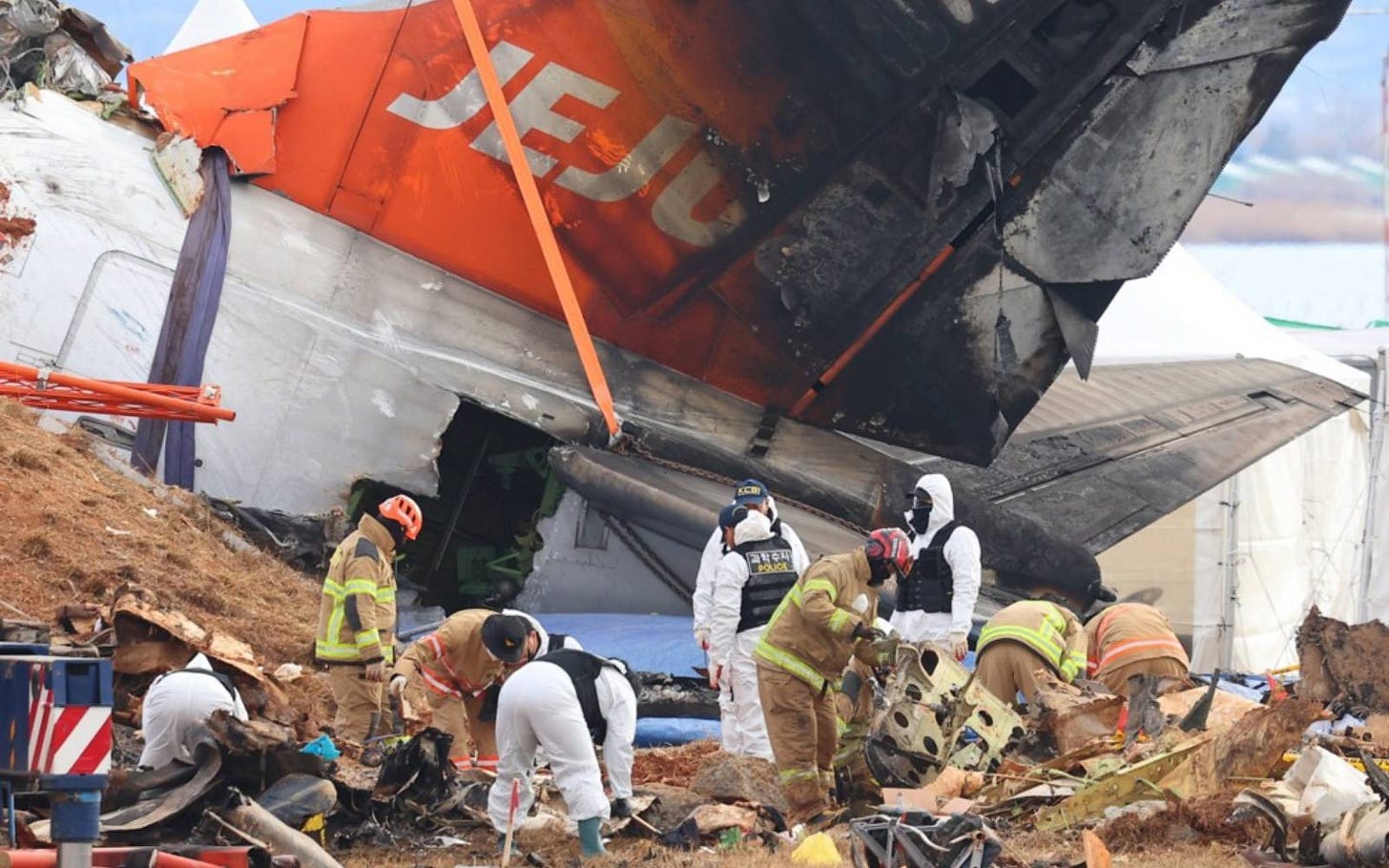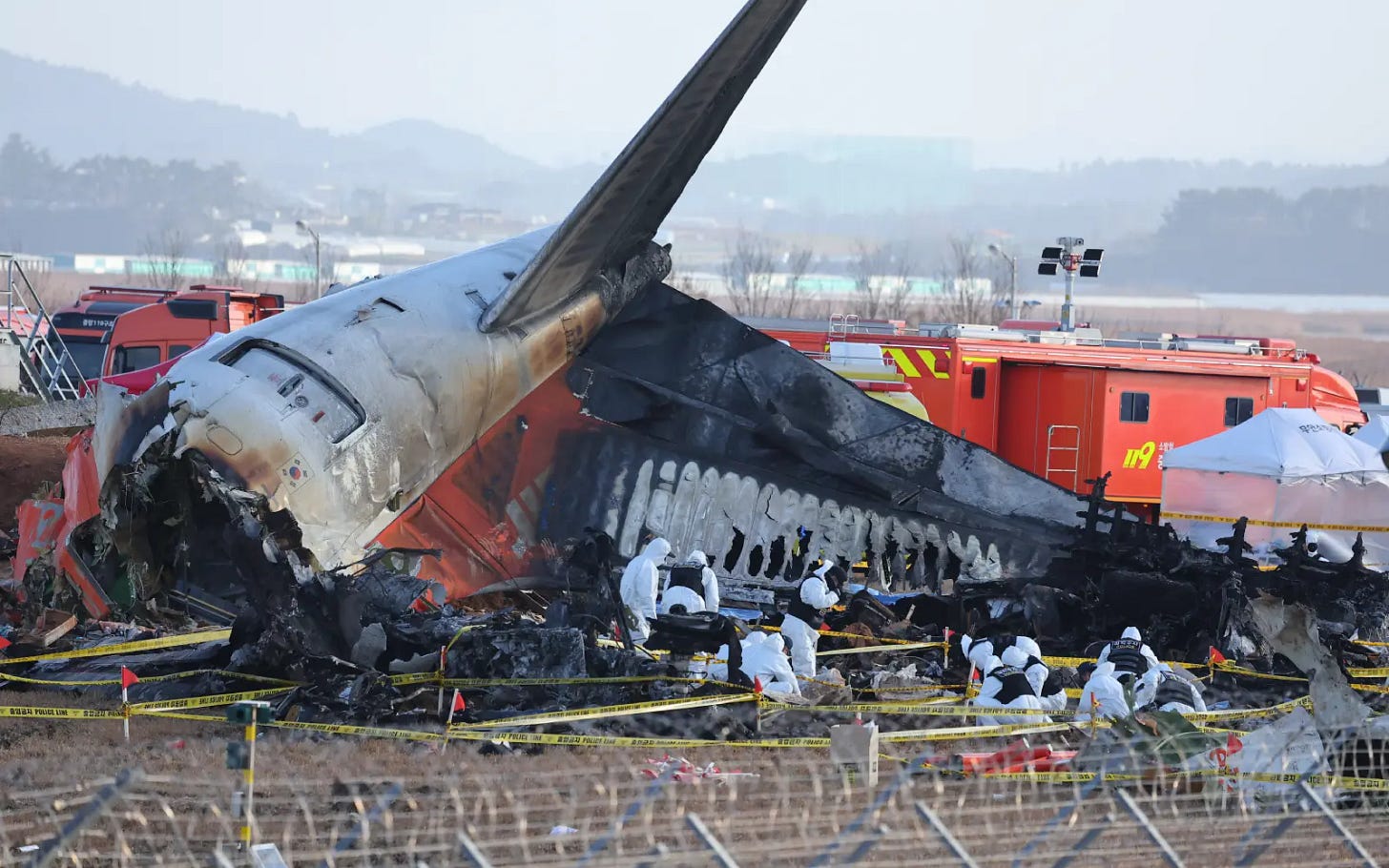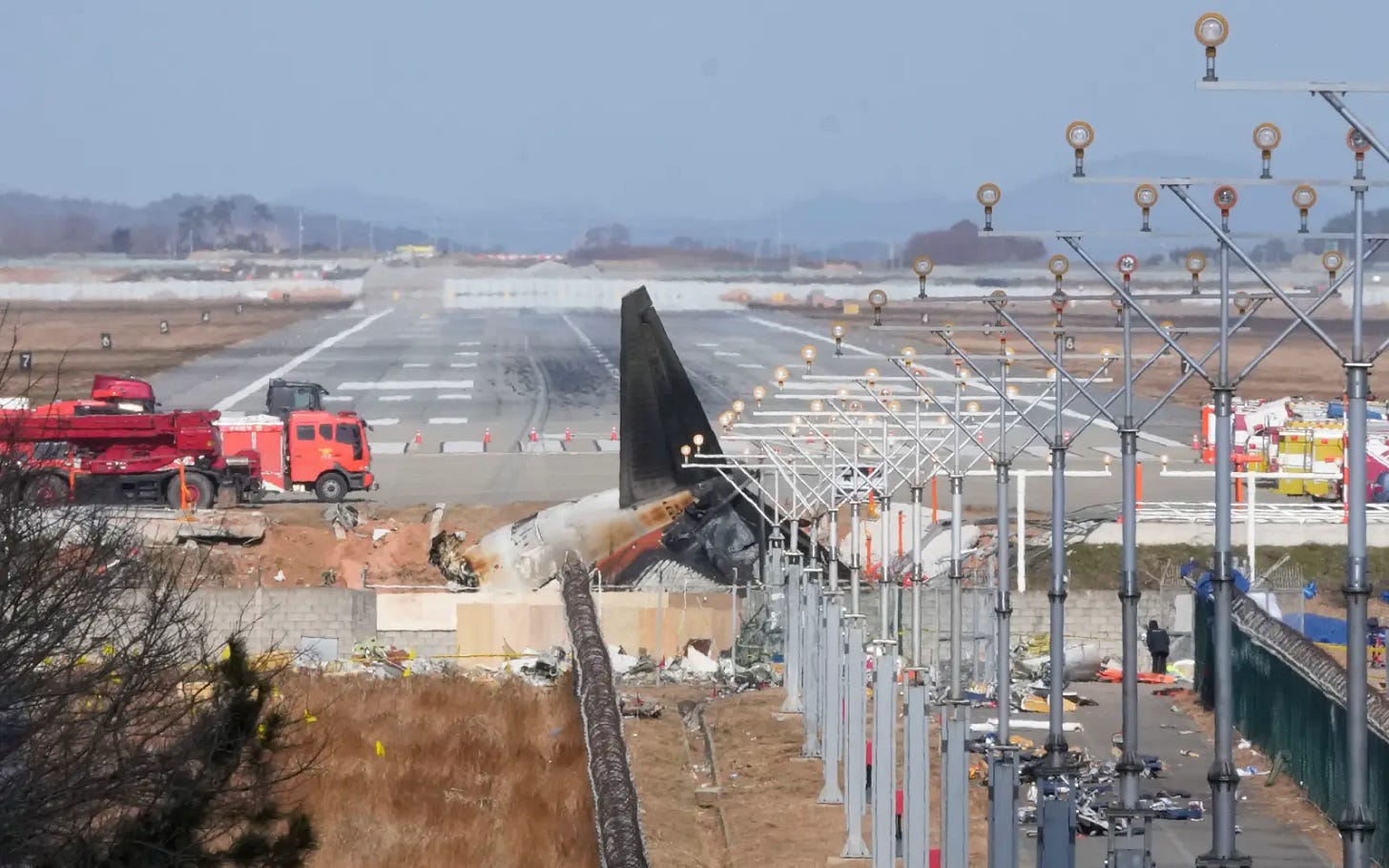25: Jeju Air Flight 2216
Unraveling the critical moments that led to a deadly aviation tragedy.
130100Z JAN 25
Good morning,
And, welcome to this special investigative edition of Flightlines.
In our last issue, I referenced a recent incident involving a Jeju Air Boeing 737 that experienced a bird strike during landing. The aircraft touched down without deploying its landing gear, skidded at high speed past the runway's end, and collided with the earthen mound housing the instrument landing system's localizer antenna. Remarkably clear video footage of the incident was captured and shared widely online [warning: the footage contains a graphic aircraft crash], providing a rare view of an aviation accident as it unfolded.
My previous mention of the incident relied too heavily on unverified reports rather than authoritative sources. While bird strikes are serious incidents, they rarely result in catastrophic accidents, making this crash particularly puzzling. The limited available information has created a vacuum that speculation and conspiracy theories have rushed to fill. I will try to distinguish verified facts from conjecture.
In this issue, I review the events of Flight 2216, acknowledging that key questions may never be answered. Let's examine the established timeline and documented evidence to separate confirmed facts from the many uncertainties that still surround this incident.
Jeju Air Flight 2216
One of the deadliest aviation accidents of 2024 occurred in its final days when Jeju Air Flight 2216, a scheduled international service from Bangkok's Suvarnabhumi Airport to Muan International Airport in South Korea, ended in disaster. The Boeing 737-800, carrying 175 passengers and 6 crew members, departed Bangkok at 02:29 local time and encountered catastrophic difficulties during its approach to Muan approximately 4 hours and 30 minutes later.
At 8:57 local time on December 29, Muan air traffic control issued a bird activity advisory. Two minutes later, the flight crew reported a bird strike and declared an emergency while executing a go-around maneuver. After being cleared to land on the opposite runway, Flight 2216 touched down approximately 1,200 meters into the 2,800-meter runway, without its landing gear deployed. Unable to stop, the aircraft overran the runway's end at a high speed and collided with a structure housing the instrument landing system's antenna array.

The impact and subsequent fire proved catastrophic. In what investigators termed a remarkable instance of survival, two cabin crew members seated in the aircraft's tail section, which separated from the main fuselage during impact, were rescued with injuries. All other occupants, including 175 passengers and 4 crew members, perished in the crash.
In the days following the crash, investigators recovered both the flight data recorder (FDR) and cockpit voice recorder (CVR), though the FDR was found damaged. More troubling was the discovery that both recorders had stopped functioning approximately four minutes before impact. The CVR's data ended during the initial approach, and despite further analysis by the U.S. National Transportation Safety Board (NTSB), the crucial final minutes remain missing.

There is ongoing debate about whether this 737-800 was equipped with backup batteries for its data recorders. While the FAA requires such additions in the United States, these are not original equipment, and not all jurisdictions mandate their installation. The complete loss of data suggests this aircraft likely did not have backup batteries, creating a significant investigative challenge in understanding the incident's final moments.
ADS-B transponder data from the aircraft also ceased at 8:58 local time, while the flight was at 900 feet on approach to runway 01. This loss of transponder data, combined with the recorder failures, suggests the aircraft experienced significant electrical issues following the bird strike. Ground observers reported seeing flames from the right engine after hearing multiple "pop sounds" consistent with bird ingestion.

The South Korean Transport Ministry has released a detailed timeline showing the progression of events. After the initial bird strike warning at 8:57, the crew declared an emergency within two minutes. The aircraft then executed a go-around and requested to land on the opposite runway. The final touchdown occurred at 9:02, just before the airport's crash alert and the aircraft's collision with the localizer array.
Muan International Airport lies near wetlands and the seashore provides ideal habitats for both resident and migratory birds. According to South Korea's aeronautical information publication (EAIP), the airport contends with several bird species, including mallards that frequent the area during winter months between October and March. Mallards typically fly at high altitudes during morning and evening hours—exactly when Flight 2216 was approaching.
Looking at the aircraft's technical state following the bird strike, investigators face several puzzling circumstances. The failure of multiple electrical systems, evidence of which coming from the loss of flight recorders and transponder data, suggests more extensive damage than typically seen in bird strike incidents. However, the crew maintained some level of aircraft control, as demonstrated by their ability to execute the go-around and attempt a second landing.
The failure to deploy landing gear during the final approach also raises a crucial question. While the 737-800 features a manual gear extension system for use during electrical failures, it remains unclear why this system wasn't utilized or whether it was even attempted. Similarly, the aircraft's flaps appeared to be retracted during the final approach, suggesting either system failures or crew decisions that investigators have yet to fully understand.

Flight 2216 presents multiple unknowns that investigators must carefully untangle. The most pressing questions center on the aircraft's electrical systems during the incident. Why did the flight recorders and transponder fail simultaneously? The loss of these critical data sources creates a significant investigative blind spot, particularly during the crucial moments before impact.
The crew's decision-making process remains particularly puzzling. Despite maintaining enough control to execute a go-around, they seemingly failed to deploy the landing gear manually—a procedure standard failure scenarios. Investigators will likely focus on reconstructing the cockpit environment through interviews, maintenance records, and any recoverable communications.
Early analysis suggests multiple potential failures: catastrophic electrical failure, significant bird strike damage, or a complex series of crew decisions under extreme stress. The two surviving cabin crew members may provide some insights, though their limited perspective from the rear of the aircraft will only offer limited information.
Flight 2216 is a reminder of aviation's inherent complexity and the thin margins between routine operation and catastrophic failure. While investigations continue, the loss of 179 lives serves as a somber call to action. Each aviation incident, no matter how rare, provides opportunities to enhance future safety protocols, aircraft design, and emergency response mechanisms.
As investigators piece together the sequence of events, the aviation community will inevitably learn and adapt. The ultimate goal remains unchanged: preventing similar tragedies through meticulous understanding of each failure. For now, Flight 2216 will remain a painful reminder of the unpredictability that can emerge even in a meticulously regulated industry. —✈
✈
Thank you for reading.
Flightlines will be back next week with more insights and updates from the world of commercial aviation.
Until then, safe travels and happy flying!




Researching what might have gone wrong and writing about the importance of making improvements to prevent future disasters is such a respectful way to honor the lives lost. 🫶